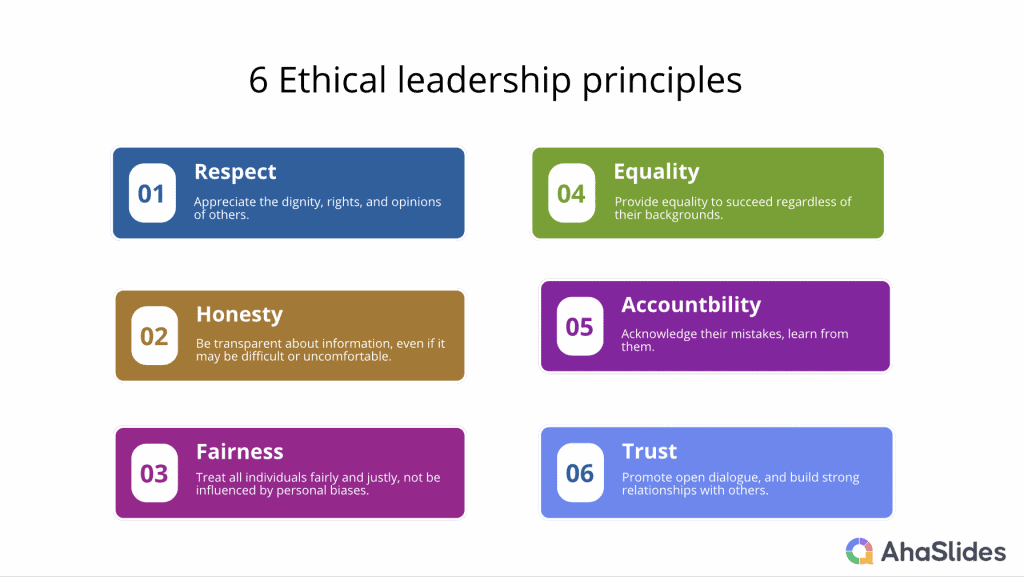Ethics and leadership are among the most complex topics to define, especially when it comes to the politics and business context, where benefits and profits are the primary goals of most organizations and companies.
Maintaining ethical leadership examples in the industry is a daunting task, which requires a concerted effort and commitment to upholding moral principles, even in the face of competing priorities.
So what are the best ethical leadership examples and principles to follow, let's get over it!
| What is ethical leadership? | promote ethical beliefs and values and for the dignity and rights of others |
| What are the 5 ethical leadership? | respect, service, community, justice, and honesty |
| Who is considered an ethical leader? | who displays good values through their words and actions |
Table of Contents:
- What is ethical leadership?
- Why is ethical leadership important?
- What are ethical leadership principles?
- 7 Ethical leadership examples
- Handle unethical leadership issues in the workplace
- Frequently Asked Questions
What is ethical leadership?
Ethical leadership is a management style that follows a code of conduct and sets the standard for others to do so as well. They lead by example, demonstrating ethical principles and values both inside and outside the workplace. At its core, ethical leadership is about doing the right thing, even when no one is watching.
It is common to see both ethical and unethical leadership nowadays, take CEOs, and politicians are ethical leadership examples. They have always been expected to maintain high ethical standards.
For example, Abraham Lincoln, a role model of ethical leadership examples, demonstrates all traits that an ethical leader should have. Or Howard Schultz - the former CEO and founder of Starbucks and the practices of ethical leadership are great ethical leadership examples as well.

Why is ethical leadership important?
Ethical leadership is essential for establishing a strong organizational culture that prioritizes integrity, trust, and accountability. It is a powerful tool that can benefit the organization and the community as a whole. Here, we've highlighted some significant benefits an organization can gain from ethical leadership.
- Improve brand image: When ethical leaders consistently make moral decisions and act with integrity, it creates a reputation of trustworthiness and reliability for the entire organization, leading to a positive brand image, and differentiating the organization from its competitors.
- Prevent scandal: The likelihood of engaging in activities that could lead to scandals, legal troubles, or public scrutiny can be reduced since ethical leadership prioritizes compliance with laws, regulations, and ethical standards.
- Increase employee loyalty: In a positive work environment like that employees feel valued and respected. This leads to higher employee retention rates and improved overall job satisfaction.
- Enhance customer loyalty: Consumers are increasingly conscious of the ethical practices of the companies they support. The more transparent the company is, the more likely that customer remains loyal.
- Attract investment: Ethical behavior can give the organization a competitive advantage when seeking investment opportunities.
What are ethical leadership principles?

To best demonstrate the principles of ethical leadership, we use the FATHER framework, an acronym for fairness, accountability, trust, honesty, equality, and respect. Here is how each principle looks:
#1. Respect
Ethical leaders demonstrate respect for the dignity, rights, and opinions of others. They create a culture where employees feel valued and appreciated for their contributions.
#2. Honesty
In ethical leadership examples, the priority of honesty and truthfulness in leader interactions is compulsory. They are transparent about information, even if it may be difficult or uncomfortable.
#3. Fairness
The third principle comes with fairness in which leaders treat all individuals fairly and justly, without favoritism or discrimination. They ensure that decisions are made based on objective criteria and are not influenced by personal biases.
#4. Equality
Equality means that all individuals are treated with respect and given equal opportunities to succeed. They are provided with equal opportunities to succeed regardless of their background, gender, race, ethnicity, religion, or any other characteristic.
#5. Accountability
Ethical leaders take responsibility for their actions and decisions. They acknowledge their mistakes, learn from them, and hold themselves and others accountable for their responsibilities.
#6. Trust
Trust is a fundamental pillar of ethical leadership. Trust is essential for effective collaboration, open dialogue, and building strong relationships with employees, customers, and stakeholders.
Related:
- What are the Best Leadership Traits in 2023?
- 18+ Qualities of a Good Leader in Modern World | Updated in 2023
- Good Leadership Skills | Top 5 Important Qualities and Examples
7 Ethical leadership examples

Check out the 7 top ethical leadership examples that you can learn and practice to become a good ethical leader.
Set a great example
“The best way to do is to be.” – Lao Tzu. Good ethical leadership examples are leaders who set themselves as a mirror to reflect the values and behaviors they expect from others. This concept is often referred to as "leading by example." They act as ethical role models and inspire their team members to demonstrate similar behavior.
Be aware of values
One of the most common ethical leadership examples is leaders who recognized values and the expectations that they place on themselves and their employees clearly. To create a shared vision among team members, they find out what really matters to their person, then align everyone toward common goals and foster a cohesive and motivated team
Manage stress effectively
Effective stress management can be one of the great ethical leadership examples that earn huge attention nowadays. Ethical leaders recognize that the well-being of their employees is crucial not only for their personal growth and satisfaction but also for the overall success of the organization.
Hire ethical employees
Another ethical leadership example that can be mentioned is value-based recruitment which means prioritizing hiring like-minded candidates who share the same perspective of ethics.
Focus on team building
Ethical leadership examples also often emphasize the importance of team building. In an ethical leadership style, there are increased opportunities for team members to work together on projects, and other team development activities such as workshops, seminars, and team-building exercises.
Promote open communication
Here are common ethical leadership examples that you might often encounter: open communication between employees and employers. Employees feel comfortable discussing their stressors and challenges, other work-related pressures, and personal issues, allowing employees to feel heard and understood.
Ban ethical violations
The importance of confronting unethical behavior directly and not turning a blind eye to it is an excellent ethical leadership example. Employees and stakeholders are more likely to trust leaders who are willing to address misconduct directly, which, in turn, enhances the organization's credibility and reputation.
Handle unethical leadership issues in the workplace?
The prevalence of leadership can be attributed to various factors, such as the complexities of modern business environments, intense competition, and the pressure to achieve short-term results.
In today's interconnected world, where information spreads rapidly, instances of unethical leadership can have severe consequences for an organization's reputation and bottom line.
Joanne B. Ciulla, a researcher that focuses on the ethical challenges of leadership gives some advice on how to deal with unethical leadership issues as follows:
- Recognizing and confronting unethical behavior when it occurs. Ignoring or tolerating unethical conduct can lead to a deterioration of trust and morale within the organization.
- Seeking support and guidance from mentors, colleagues, or HR professionals. Having open discussions and sharing concerns with trusted individuals
- Staying true to your values and not compromising them due to external pressures.
- Keeping a record of unethical actions can be helpful when discussing concerns with relevant authorities or higher-ups.
- Express your concerns and observations, and be open to listening to the other person's perspective.
⭐️ For leaders, better team management can be done with surveys and frequent open communication. Forget formal and dull survey style, AhaSlides provides anonymous surveys and live quizzes that connect every member together in relaxed and comfortable meetings. Check out AhaSlides right away to get more inspiration.
- Coaching Style of Leadership in 2023 | An Ultimate Guide with Examples
- Pacesetting Leadership | All Examples You Need to Know in 2023
- Affiliative Leadership | Ultimate Guide For Beginners with Examples 2023
- Effective Visionary Leadership | Best Updated in 2023
- Top 8 Examples of Transactional Leadership in 2023
Frequently Asked Questions
Is Elon Musk a good ethical leader?
Musk is one of the famous ethical leadership examples because he does not compromise his values for anything. His commitment is to solving global challenges, such as space exploration and climate change, and he's going to write himself out to do it.
Is Bill Gates an ethical leader?
Bill Gates’s philanthropic work at least explains a serious effort at ethical leadership, he ensure his company grew at the pace that he had envisioned.
What are the 7 habits of strong ethical leadership?
The 7 habits of strong ethical leadership examples are: (1) lead by example; (2) set clear objectives; (3) control performance; (4) reward good work frequently and correctly; (5) communicate effectively; (6) promote ideas and initiative; (7) adapt your teams.
Ref: BetterUp | Business News Daily | Indeed








